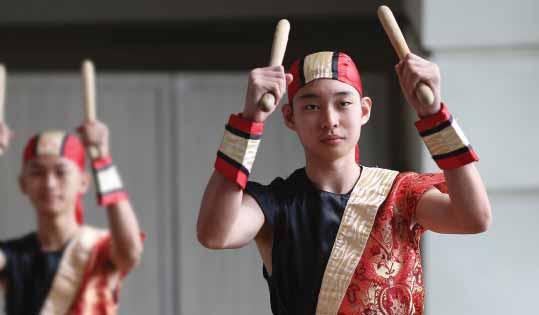
7 minute read
Musical roots

Continuing with our exploration of access to music and arts education, we look at the topic of cultural identity and particularly its relevance in teaching by exploring research articles on this topic and chatting with teacher and researcher Arzu Soysal Altugan, PhD
Photos: Images from Pixabay and iStock (midde row, left: Zeynep Bog˘oçlu and midde row, right: Nikola Stojadinovic) In the July/August issue of Music Journal we informed you that as an organisation ISM was planning to explore the topic of racism within our sector and to look at the wider questions of access to music and arts education. In our September/October issue ISM member, violinist, performer and teacher Mahaliah Edwards recounted her journey of learning, performing and teaching music as a person of colour. Last month, we celebrated Black History Month through various channels including signposting relevant resources, publishing a variety of blogs and compiling our Black Classical Composers’ Playlist. Now, we look at the topic of cultural identity and the importance of bearing this in mind when delivering your music lessons to help and encourage your students in their learning experience.
There has been much discussion and academic research into the area of cultural identity. Turkish teacher and researcher Arzu Soysal Altugan, PhD explored this topic in her paper The Effect of Cultural Identity on Learning, delivered to the second Global Conference on Psychology Researches in 2014. Commenting on why she chose this topic as her area of study, Altugan observed: ‘I have been interested to study cultures as it is one of the big stepping-stones in learning and teaching. Cultures are the phenomena that shape people’s lives, provide information about the new way of life, and when blended, the society. However, it is very important to know the culture of the society being studied or taught in order to be able to construct knowledge. It is signifi cant to remember that teaching is a kind of transferring of cultural values to a part of life. Of course, the reasons for wanting to learn about a culture are not just those I wrote about. Learning about different cultures at the point of education can be a great factor in making people’s jobs easier.’
In relation to the importance of understanding students’ cultural identities when teaching, Altugan looked at her personal experience. ‘After all, in order to work and teach in a different country, one has to know about the country’s or the people’s way of life. For this, of course, understanding the culture and how each person has constructed their cultural identity comes into play. Otherwise, one might come across diffi culties or blocks leading to personal barriers to teaching or learning. For this reason, learning each student’s cultural background and how they constructed it provides a healthier development in cultural, educational, commercial and other issues.’
The aim of Altugan’s research was to fi nd out about the links between cultural identity and learning; and she therefore explored this question from two angles. Firstly, how a student’s cultural identity can affect their motivation to learn. Altugan observes in her article: ‘It can be said the immigration reasons of the students showed that in general have a positive effect on their education. They happily moved here because of job opportunities and having a better lifestyle ... However, would these reasons be enough to have positive effects on their education? The concept of a selffulfi lling can be seen in the classes where students might fi nd themselves negatively labelled. Some immigrant students expressed that they feel that they do not have a right to speak in class. However, when a classroom is open for exchanging ideas rather than suppressing, all students might benefi t as the students who are from different cultural identities but minorities may feel that they have a place in that classroom and they have a right to make themselves heard and can develop their own perspectives by improving their self-esteem. Other students can also benefi t from these different perspectives and develop their knowledge. It obviously can be seen that there are cultural identity differences, therefore, in order
Above photo: Rixipix

to ensure effective learning outcomes students and teachers should develop intercultural understanding.’
Secondly, Altugan examined the cultural identities of the students themselves to see how their perceptions of their identity affected their ability to learn. Altugan comments on factors that affected her own students: ‘I have observed so many learning problems so far. I was a student and I have been a teacher for a long time in North Cyprus. I can easily say that especially after the 1974 war, there have been a lot of cultural changes, not only because of the effects of post colonialism and war but also because of globalisation and technology.’ She goes on to say: ‘I know that there are different types of students in each class … the question is how we can bridge the gap between students and utilise their learning.’
Altugan answers this question in her fi ndings: ‘… some strategies should be put forward to increase the positive effects and decrease the negative effects … most teachers encounter students from different cultures in classes. Therefore, teachers have to work as much as possible and plan their lessons accordingly. This can be possible by being aware of cultural identity to see the features and characteristics of each learner better and more importantly to learn the learning strategies of each student to be able to teach mixed classes better. Factors related to the learners’ nationality, which might ease or unease their learning, should be searched.’
Asked if there’s anything she would say to music teachers who fi nd themselves teaching children with different cultural identities, Altugan responds: ‘As a teacher, I would say all teachers should have the knowledge about their students’ cultural identities in order to be able to teach, to guide and to facilitate learning better.’
Altugan’s full article can be read at: core.ac.uk/ download/pdf/82082928.pdf and sciencedirect. com/science/article/pii/S187704281503267X
Arzu Soysal Altugan, PhD obtained three degrees (Public Management, ELT and Education Management; two MA’s in ELT obtained at Near East University and Cambridge University) before pursuing her doctoral research PhD, at London Metropolitan University. Altugan has also worked as an English teacher in different schools and universities, published her own work and has contributed to publications and research.
Other research exploring cultural identity
The role that music plays in cultural identity was explored by HERA (Humanities in the European Research Area), which carried out a project that examined the role and signifi cance of popular music in shaping cultural identity and heritage at both a local and national level. HERA is a partnership between 26 Humanities Research Councils across Europe and the European Commission including the United Kingdom and the project examined popular music’s contribution to the narratives of cultural identity and representations of cultural memories. Various research papers were written as part of this project, including Unauthorising popular music heritage: outline of a critical framework by Sara Cohen, Professor of Music at the University of Liverpool and Dr Les Roberts, also of the University of Liverpool. The paper set out a framework to explore the ways in which popular music heritage in the UK is understood, discussed, critiqued, practised or performed. And Music in the margins? Popular music heritage and British Bhangra music by Dr Gurdeep Khabra, which explored the relationship between popular music and cultural identity through a focus on British Bhangra and looked into the way that popular music plays a role in the negotiation of cultural identity in a local and national context. Both papers can be read at: tandfonline.com/doi/full/10.1080/1 3527258.2013.779294 Sound Connections explored the topic of cultural identity from another angle in its report Increasing Musical Diversity and Inclusion in Early Childhood. The aim of the Sound Connections project was to look at racial diversity and increasing inclusion within the workforce; it was inspired by the observation that when a Tri-borough Music Hub project placed ten musicians to work with ten early childhood practitioners, six of whom were from diverse ethnic backgrounds, the musicians overlooked the musical identity of the childhood practitioners they were paired with and did not explore the potentials of musical diversity. The full report can be read at: sound-connections.org.uk/wp-content/uploads/ Increasing-Musical-Diversity-and-Inclusion-inEarly-Childhood-Settings.pdf
Rolf Lidskog, Professor of Sociology at the Centre for Urban and Regional Studies at Örebro University, Sweden explored cultural identity in his literature review The role of music in ethnic identity formation in diaspora: a research review. The review investigates the role of music in cultural identity formation among ethnic groups, focusing on how ethnic identities and cultures are maintained and transformed in diasporic situations, namely though music. His literature review can be read at: onlinelibrary.wiley.com/doi/10.1111/ issj.12091
Below photo: Alex Liew Photo taken prior to COVID-19 lockdown










